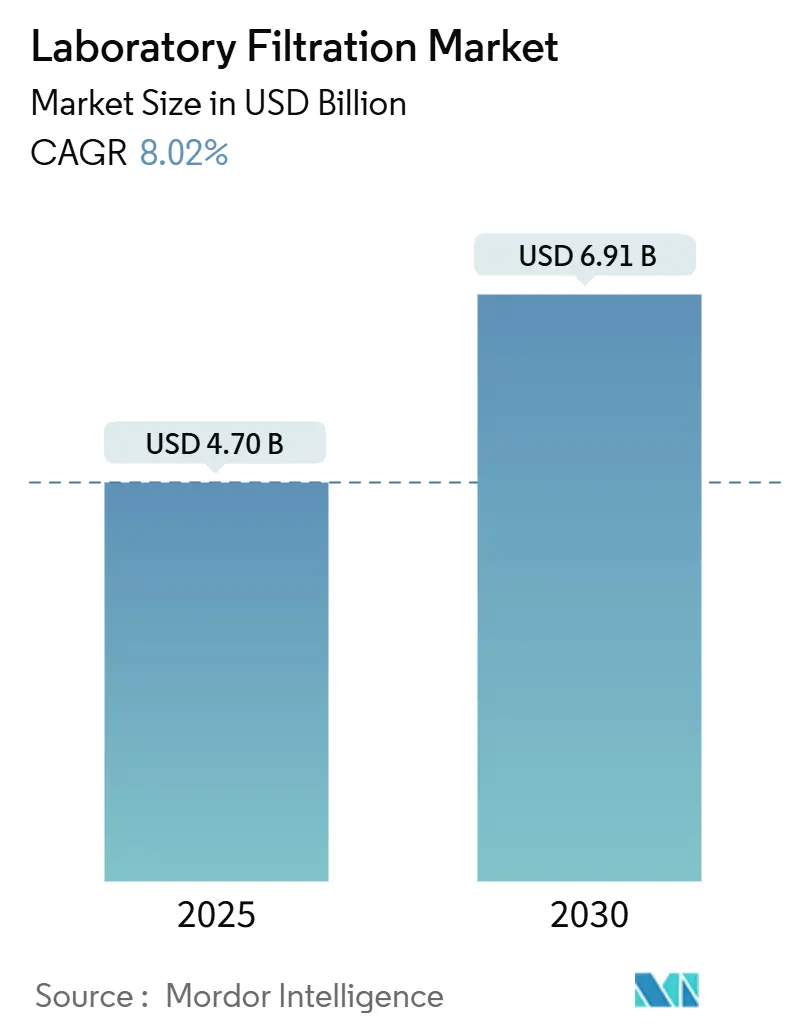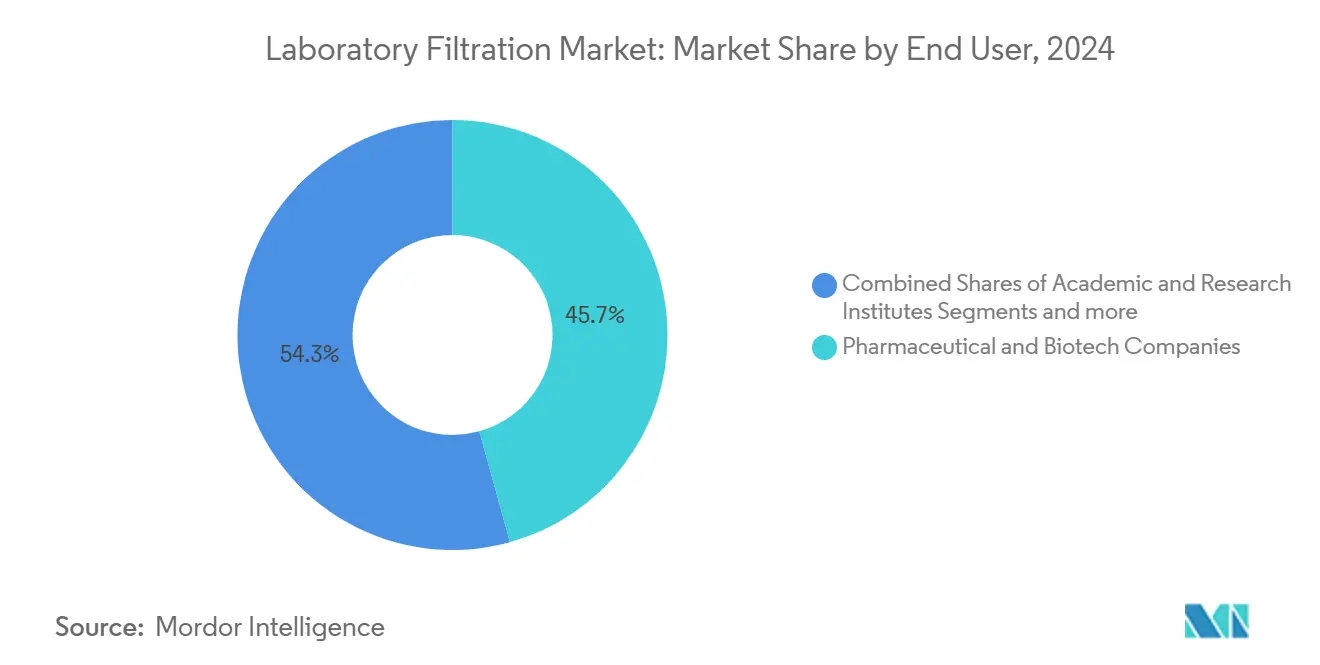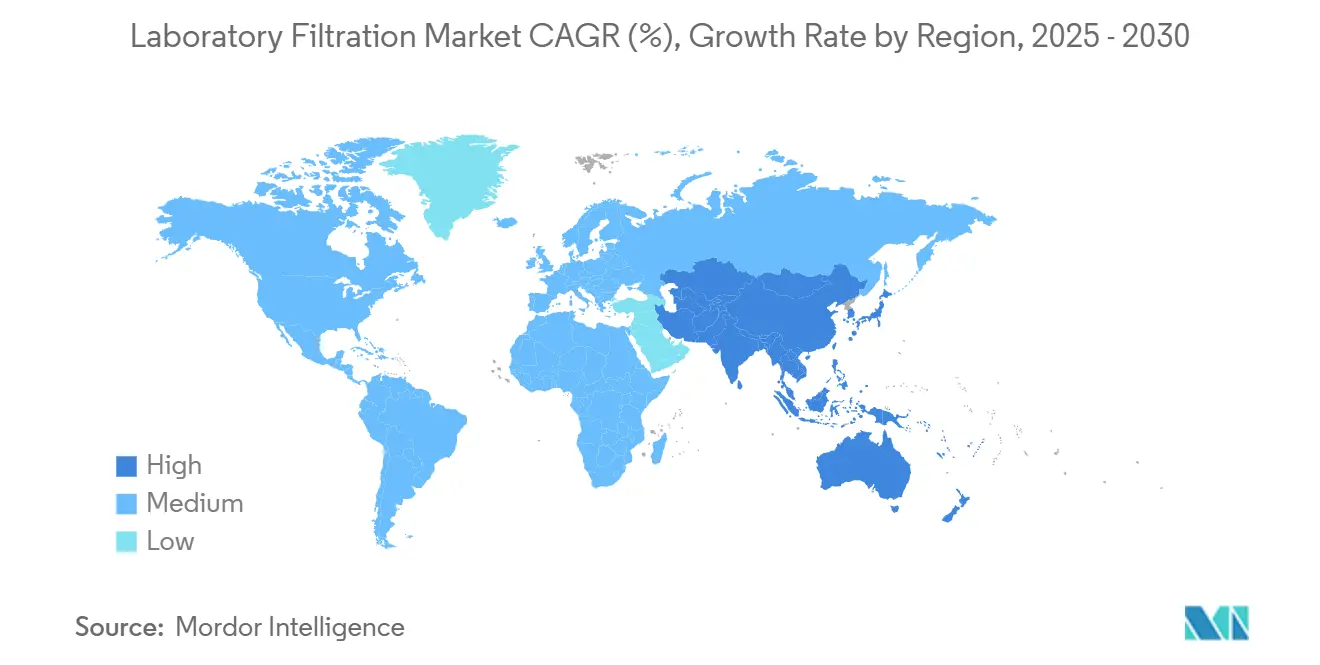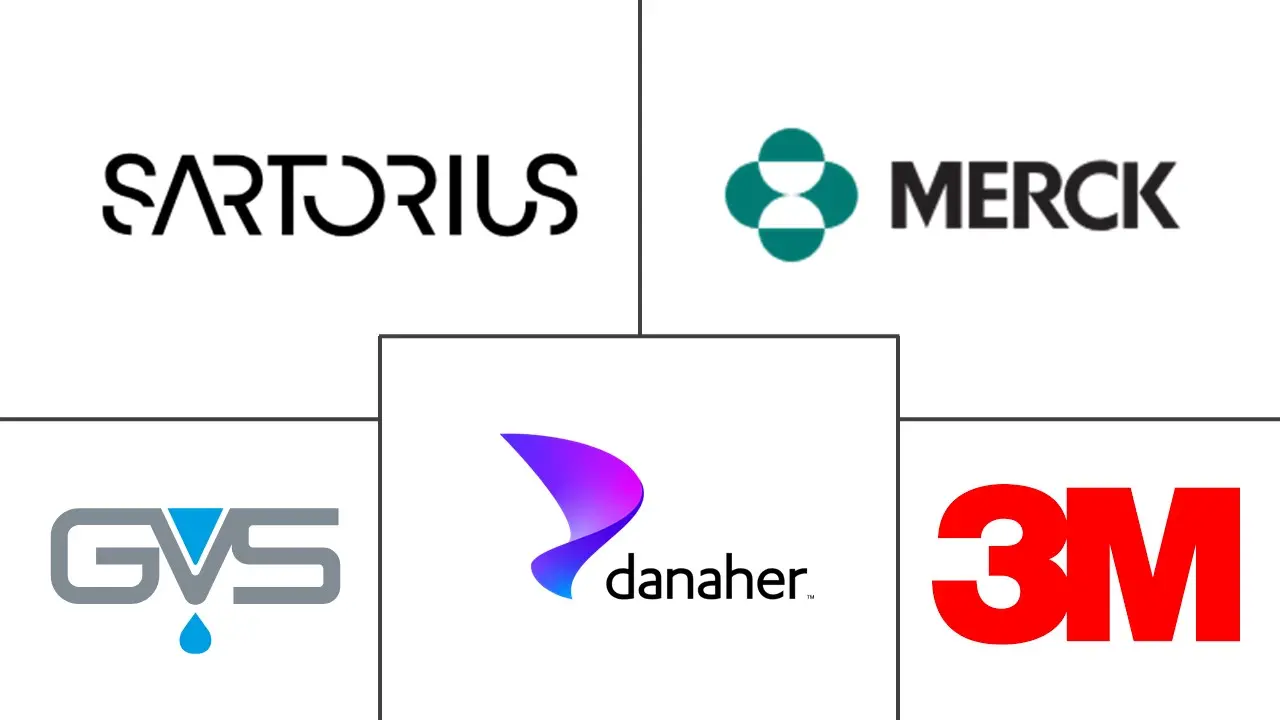Laboratory Filtration Market Size and Share

Laboratory Filtration Market Analysis by Mordor Intelligence
The Laboratory Filtration Market size is estimated at USD 4.70 billion in 2025, and is expected to reach USD 6.91 billion by 2030, at a CAGR of 8.02% during the forecast period (2025-2030).
Rising biopharmaceutical production volumes, rapid adoption of single-use process technologies, and escalating purity requirements in advanced research workflows underpin this expansion. Precision-grade microfiltration continues to anchor routine clarification steps, while breakthrough nanofiltration platforms are gaining traction for molecular-level separations in cell and gene therapy pipelines. Heightened outsourcing to contract research and development manufacturing organizations (CRDMOs) is widening access to flexible filtration assemblies, and sustainability initiatives are accelerating the shift toward PFAS-free membranes. Competitive differentiation now revolves around virus-retentive performance, automation readiness, and digital compatibility, encouraging a steady wave of product upgrades and platform integrations across the laboratory filtration market.
Key Report Takeaways
- By technology, microfiltration led with 40.2% revenue share in 2024, whereas nanofiltration is poised to advance at a 9.6% CAGR through 2030.
- By product, filtration media accounted for 58.7% of the laboratory filtration market size in 2024, while filtration assemblies are set to grow at an 9.1% CAGR over the same period.
- By end-user, pharmaceutical and biotechnology companies accounted for 45.7% of the laboratory filtration market size in 2024, while CRO and CDMO are set to grow at an 10.2% CAGR over the same period.
- By geography, North America commanded 36.4% of the laboratory filtration market share in 2024, while Asia-Pacific is forecast to expand at a 10.7% CAGR between 2025-2030.
Global Laboratory Filtration Market Trends and Insights
Drivers Impact Analysis
| Driver | (~) % Impact on CAGR Forecast | Geographic Relevance | Impact Timeline |
|---|---|---|---|
| Rapid expansion of biologics manufacturing | +2.1 | North America, Europe, emerging Asia | Medium term (2-4 years) |
| Miniaturization of genomics & proteomics workflows | +1.3 | North America, Europe, advanced Asian markets | Medium term (2-4 years) |
| Growth of CROs & CDMOs | +1.8 | Global with focus in Asia-Pacific | Short term (≤ 2 years) |
| Rise in R&D spending by biotechnology industries | +1.5 | North America, Europe, global | Medium term (2-4 years) |
| Technological advancements in laboratory filtration | +1.9 | Global, early adoption in advanced markets | Long term (≥ 4 years) |
| Sustainability-driven filtration innovation | +1.4 | Global, strongest in Europe & North America | Long term (≥ 4 years) |
| Source: Mordor Intelligence | |||
Rapid expansion of biologics manufacturing
Biologics pipelines are scaling quickly in monoclonal antibodies, recombinant proteins, vaccines, and cell-based therapies. Downstream purification now demands sterile, virus-retentive filters that handle higher titers without compromising biomolecule integrity. Asahi Kasei Medical’s Planova FG1 filter, released in October 2024, demonstrates a seven-fold increase in volumetric throughput for antibody processing while preserving virus clearance performance.[1]Asahi Kasei Medical, “Planova FG1 Virus Removal Filter,” asahikasei.com Strong demand for single-use bag-integrated cartridges further propels the laboratory filtration market as manufacturers build flexible plants capable of rapid product changeovers.
Miniaturization of genomics & proteomics workflows
High-throughput sequencing and multiplexed proteomics have condensed sample volumes from milliliters to microliters. Filtration devices compatible with 96- and 384-well plates are now standard in next-generation sequencing (NGS) library preparation and biomarker validation assays. Cytiva’s Whatman Mini-UniPrep G2 syringeless filters combine protein precipitation, particulate removal, and autosampler vial integration in one step, cutting plastic use and hands-on time while meeting the precision needs of ultrahigh-performance liquid chromatography (UHPLC).[2]Cytiva, “Whatman Mini-UniPrep G2 Syringeless Filters,” cytiva.com Automation-friendly formats position the laboratory filtration market for sustained uptake in digital, walk-away genomics platforms.
Growth of CROs & CDMOs
Outsourcing models continue to expand in discovery chemistry, pre-clinical screening, and clinical-stage biologics production. Contract partners demand modular, ready-to-use filtration skids that switch rapidly between client projects. End-to-end CRDMO offerings drive procurement of standardized, validated filter trains that guarantee repeatable performance from upstream cell harvest through final fill. The trend is particularly pronounced in Asia-Pacific, where capacious multitenant facilities serve global biopharma sponsors.
Rise in R&D spending by biotechnology industries
Government and private funding streams are channeling billions into life-science innovation. The United States National Institutes of Health alone directed USD 4,901 million to health disparities research in 2023 and budgeted USD 5,246 million for 2024, reinforcing a robust pipeline of exploratory projects that rely on consistent, high-purity filtration steps.[3]National Institutes of Health, “NIH Research Portfolio Online Reporting Tools,” nih.gov New laboratory build-outs directly translate into higher throughput requirements for membrane filters, depth filters, and hybrid media.
Restraints Impact Analysis
| Restraint | (~) % Impact on CAGR Forecast | Geographic Relevance | Impact Timeline |
|---|---|---|---|
| Reuse of sterilizing-grade filters & high cost | -1.2 | Emerging markets; budget-constrained labs worldwide | Short term (≤ 2 years) |
| Variability in nanoporous membranes | -0.7 | Advanced research settings worldwide | Medium term (2-4 years) |
| Consolidation of pharma buyers | -1.1 | Global, strongest in mature pharma hubs | Medium term (2-4 years) |
| PFAS-driven reformulation costs | -0.9 | North America, Europe | Short term (≤ 2 years) |
| Source: Mordor Intelligence | |||
Reuse of sterilizing-grade filters & high cost
Laboratories under fiscal pressure often attempt to recycle expensive sterilizing-grade membranes, reducing consumable spend by up to 50% but amplifying contamination and validation risks. The burden is acute in small academic labs and resource-limited geographies, where filter integrity testing infrastructure may be lacking.
Variability in nanoporous membranes
Batch-to-batch inconsistencies in pore size, porosity, and surface energy undermine reproducibility in sensitive biologics assays. Even minor deviations skew protein recovery yields, prompting costly re-runs and eroding confidence among quality-assurance teams.
Segment Analysis
By Technology: Nanofiltration Gains Strategic Momentum
The laboratory filtration market size for microfiltration amounted to 40.2% of global revenue in 2024, underscoring its ubiquity in microorganism removal and sample clarification tasks. Nanofiltration, however, is on pace to compound at 9.6% annually to 2030 as laboratories adopt molecular-level cutoffs for virus clearance, salt-selective separations, and therapeutic-grade buffer production. The FilmTec LiNE-XD element from DuPont illustrates this shift, achieving high lithium passage while excluding multivalent ions critical to battery-material quality control.
Ultrafiltration and reverse osmosis remain cornerstones for protein concentration and ultrapure water generation respectively. Hybrid membranes combining graphene oxide channels with polymer backbones point toward the next wave of cross-disciplinary breakthroughs. Such innovations blur legacy boundaries, compelling vendors to articulate performance metrics in terms relevant to biotherapeutics, semiconductor rinsing, and environmental testing alike.

Note: Segment shares of all individual segments available upon report purchase
By Product: Assemblies Elevate Workflow Efficiency
Filtration media maintained a 58.7% laboratory filtration market share in 2024 spanning membrane discs, syringe filters, filter papers, and plate formats. Yet integrated assemblies self-contained devices bundling housings, membranes, and connectors are accelerating at an 9.1% CAGR as lab managers streamline set-up and validation tasks. Thomas Scientific’s PUREGRIP solvent reservoir assemblies typify designs that reduce solvent waste and operator exposure.
Syringeless filters continue to win favor for chromatography sample prep, minimizing dead volume and plastic load. Capsule filters, shipped gamma-sterile, are scaling in downstream biologics to mitigate cross-batch contamination risk. Complementary accessories such as manifold racks and vacuum pumps complete modular systems, allowing laboratories to tailor configurations to specific sample matrices without compromising compliance.
By End User: Pharmaceutical & Biotechnology Labs Retain Leadership
Pharmaceutical and biotechnology companies commanded 45.7% of global demand in 2024, reflecting rigorous current Good Manufacturing Practice (cGMP) requirements and high-volume drug substance runs. CRO and CDMO facilities show the steepest order growth as they qualify universal filtration skids for client molecules, pushing vendors to bundle validation guides and regulatory support with a 10.2% CAGR to 2030.
Academic and government research institutes rely heavily on grant-funded acquisitions that prioritize versatility over scale, while hospital and diagnostic labs integrate point-of-care filtration cartridges into rapid testing platforms.

Note: Segment shares of all individual segments available upon report purchase
Geography Analysis
North America generated the largest share 36.4% of the laboratory filtration market in 2024 owing to its advanced pharmaceutical R&D, dense biotech clusters, and strict quality regulations. Boston’s Kendall Square, the San Francisco Bay Area, and San Diego collectively orchestrate high-throughput biologics discovery pipelines, securing recurring orders for sterilizing-grade media, depth filters, and disposable capsules. Canada’s biologics capacity expansion programs and Mexico’s cost-competitive fill-finish facilities further elevate regional unit volumes.
Asia-Pacific is the most dynamic arena, advancing at a 10.7% CAGR through 2030. China’s provincial life-science parks are outfitting greenfield plants with single-use filtration trains to support mRNA vaccines and gene-edited cell therapies. Singapore’s Biomedical Sciences Initiative and South Korea’s pharmaceutical stimulus packages intensify local demand for automation-ready filtration units, while Japan sustains premium segments with ultra-high precision membrane grades. India’s generics producers reinforce bulk-drug filtration throughput, emphasizing cost-efficient media that maintain compliance with PIC/S harmonization guidelines.
Europe maintains significant weight in the global laboratory filtration market. Germany’s engineering heritage fosters steady adoption of advanced membrane modules, and the United Kingdom’s cell therapy manufacturing ecosystem drives specialty filter designs optimized for viral vector purification. France, Switzerland, and the Nordic countries extend the region’s footprint with strong analytical testing sectors. In South America, Brazil anchors investment in vaccine fill-finish lines, whereas the Middle East & Africa are witnessing incremental gains tied to national immunization and water-quality programs.

Competitive Landscape
The laboratory filtration market features moderate fragmentation characterized by diversified life-science conglomerates and focused membrane innovators. Merck KGaA (MilliporeSigma) leverages depth-filter advances such as the Millistak+ HC Pro Pod, which halves total organic carbon extractables and doubles throughput relative to diatomaceous-earth filters. Danaher’s Pall and Cytiva subsidiaries synergize hollow-fiber ultrafiltration with automation-ready hardware, furnishing turnkey virus-clearance trains. Sartorius strengthens digital integration following Labforward’s merger with LabTwin, pairing filtration consumables with data-rich laboratory execution systems.
Acquisition activity centers on niche capabilities virus filtration specialists, sustainability-oriented membrane fabricators, and software firms with AI-enabled predictive maintenance algorithms. Start-ups differentiate via graphene-oxide channels, COF scaffolds, or solvent-resistant nanomaterials to service specialty chemicals and microelectronics. Sustainability remains a fertile white space; Hollingsworth & Vose’s PlusZero PFAS-free solution signals rising demand for fluorine-free offerings that satisfy forthcoming regulatory thresholds.
Laboratory Filtration Industry Leaders
-
Merck KgaA
-
Danaher Corporation
-
3M Company
-
Sartorius AG
-
GVS S.p.A
- *Disclaimer: Major Players sorted in no particular order



Recent Industry Developments
- December 2024: Ahlstrom unveiled new sustainable PFAS-free filtration media for air-oil separation with advanced water-repellent properties, addressing growing environmental concerns in laboratory and industrial applications.
- October 2024: Asahi Kasei Medical launched the Planova FG1 next-generation virus removal filter, offering approximately seven times the filtration speed of its predecessor while maintaining robust virus removal capabilities for monoclonal antibody production.
- September 2024: Sartorius launched new laboratory-focused Tangential Flow Filtration (TFF) Cassettes designed to enhance the efficiency of TFF processes, facilitating the clarification of process fluids and concentration of macromolecules.
- June 2024: Merck KGaA launched the Millistak+ HC Pro Pod Depth Filter, a synthetic depth filter designed for laboratory applications that reduces TOC extractables and pre-use flush volume by 50% while providing up to twice the filtration capacity compared to traditional DE-based filters
- November 2023: Repligen Corporation, a prominent in bioprocessing solutions, made a significant advancement in Tangential Flow Filtration (TFF) technology. It introduced the TangenX SC device, a novel device that eliminates the need for traditional cassette holders. This TFF technology is used for ultrafiltration and diafiltration (UF/DF).
Research Methodology Framework and Report Scope
Market Definitions and Key Coverage
Our study treats the laboratory filtration market as the sale of disposable and reusable media, assemblies, and accessories used to separate particulates from liquids or gases inside research, quality-control, and diagnostic laboratories. The valuation includes units supplied to pharmaceutical, biotechnology, academic, and clinical settings and is expressed in end-user spending terms. According to Mordor Intelligence analysts, this scope places the 2025 global market at USD 4.70 billion.
Exclusion: Industrial process filters, large-volume water or HVAC cartridges, and single-use bioprocess systems sold for commercial manufacturing are outside the frame.
Segmentation Overview
- By Technology
- Microfiltration
- Ultrafiltration
- Reverse Osmosis
- Vacuum Filtration
- Nanofiltration
- By Product
- Filtration Media
- Membrane Filters
- Filter Papers
- Filtration Microplates
- Syringeless Filters
- Syringe Filters
- Capsule Filters
- Filtration Assemblies
- Microfiltration Assemblies
- Ultrafiltration Assemblies
- Vacuum Filtration Assemblies
- Reverse Osmosis Assemblies
- Nanofiltration Assemblies
- Filtration Accessories
- Filtration Media
- By End User
- Pharmaceutical and Biotechnology Companies
- Academic and Research Institutes
- CRO and CDMO
- Hospital and Diagnostic Laboratories
- By Geography
- North America
- United States
- Canada
- Mexico
- Europe
- Germany
- United Kingdom
- France
- Italy
- Spain
- Rest of Europe
- Asia-Pacific
- China
- Japan
- India
- Australia
- South Korea
- Rest of Asia-Pacific
- Middle East & Africa
- GCC
- South Africa
- Rest of Middle East & Africa
- South America
- Brazil
- Argentina
- Rest of South America
- North America
Detailed Research Methodology and Data Validation
Primary Research
Telephone interviews and short surveys with laboratory managers, quality officers at CRO/CDMOs, procurement heads in biotech start-ups, and regional distributors across North America, Europe, and Asia-Pacific validated usage intensity, replacement cycles, and emerging media preferences. These expert conversations filled gaps on discount structures and confirmed the relative uptake of nanofilters versus classic microfiltration membranes.
Desk Research
We first mapped the universe of laboratories by mining open datasets such as OECD Main Science & Technology Indicators, NIH RePORT, and Eurostat R&D expenditure tables. We then cross-checked filter import volumes on UN Comtrade and national customs dashboards. Standards documents from bodies such as the US USP, European Pharmacopeia, and WHO guidelines clarified regulatory drivers behind technology shifts. Company 10-Ks, investor decks, and conference proceedings supplied recent average selling prices and channel mixes. Paid repositories, such as D&B Hoovers for company sales trends and Dow Jones Factiva for real-time deal news, added depth. The sources cited are illustrative; numerous additional public and proprietary references supported data gathering and clarification.
Market-Sizing & Forecasting
A top-down reconstruction starts with the population of operational labs, applies penetration rates for each filtration technique, and pairs those volumes with region-specific ASPs, which are then stress-tested through selective bottom-up supplier roll-ups. Key inputs include active biotech pipeline counts, average R&D spend per bench scientist, lab automation adoption ratios, membrane throughput yields, and cartridge change-out norms. Multivariate regression links these drivers to historic sales, and scenario analysis adjusts for shifts in biologics funding or macroeconomic slowdowns. Where respondent data were thin, conservative interpolation bridged the gap before final reconciliation.
Data Validation & Update Cycle
Model outputs pass variance checks versus independent trade data, and anomalies trigger second-round expert calls. Senior Mordor reviewers sign off only after currency conversion parity and growth-rate sanity checks. The dataset refreshes annually, with interim adjustments if material events, such as supply disruptions or major capacity additions, arise.
Why Our Laboratory Filtration Baseline Inspires Confidence
Published market numbers rarely match because firms choose different product buckets, price benchmarks, and forecast cadences. Mordor's disciplined scope, dual-path modeling, and yearly refresh reduce those variances for decision-makers.
Benchmark comparison
| Market Size | Anonymized source | Primary gap driver |
|---|---|---|
| USD 4.70 Bn (2025) | Mordor Intelligence | |
| USD 4.10 Bn (2024) | Global Consultancy A | excludes accessories and assumes one global ASP |
| USD 3.61 Bn (2022) | Industry Association B | relies on historical sales only and limited regional coverage |
The comparison shows that narrower scopes, older base years, or uniform pricing explain most gaps, whereas Mordor's mixed-method approach and timely updates deliver a balanced, transparent baseline clients can trust.


Key Questions Answered in the Report
What is the current size of the laboratory filtration market?
The market is valued at USD 4.7 billion in 2025 and is projected to reach USD 6.9 billion by 2030.
Which technology segment is growing the fastest?
Nanofiltration is forecast to grow at a 9.6% CAGR between 2025-2030, outpacing other filtration technologies.
Why is Asia-Pacific the fastest-growing region?
Rapid expansion of biopharmaceutical manufacturing capacity, coupled with rising outsourcing to CRO and CDMO, drives a 10.2% CAGR in the region
Which companies lead the laboratory filtration market?
Merck KGaA, Danaher (Pall & Cytiva), and Sartorius AG dominate through diversified portfolios and continuous product innovation.
How are sustainability regulations affecting laboratory filtration purchasing?
PFAS restrictions are prompting labs to adopt PFAS-free membranes and assemblies, stimulating innovation but also adding reformulation costs for suppliers.
Page last updated on:








